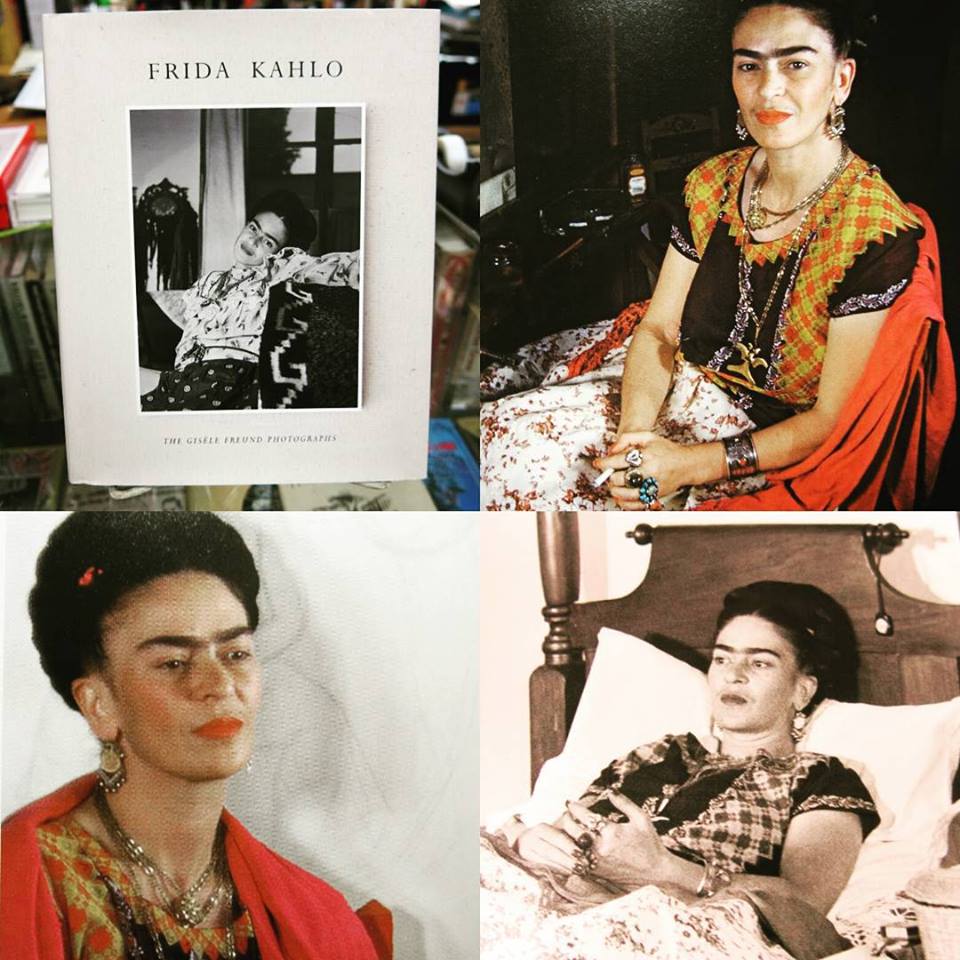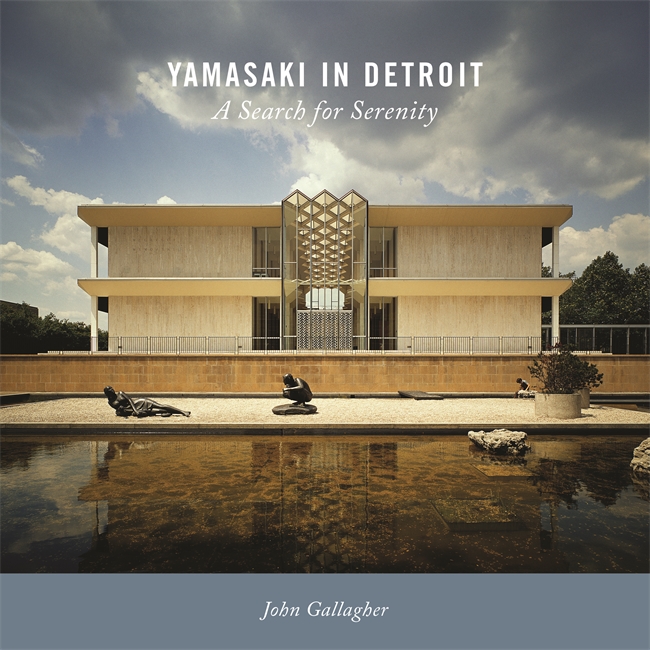
DETROIT UNBROKEN DOWN. Dave Jordano returned to his hometown of Detroit to document the people who still live in what has become one of the country’s most economically challenging cities. Jordano discovers and rebroadcasts a message of hope and endurance to an otherwise greatly misunderstood and misrepresented city. Detroit: Unbroken Down is not a document solely about what’s been destroyed, but even more critically, about all that has been left behind and those who remain to cope with it. Signed first edition copies available, $50.00

Frida Kahlo: The Gisèle Freund Photographs. In 1950, photographer Gisèle Freund embarked on a two-week trip to Mexico, but she wouldn’t leave until two years later. There she met the legendary couple Frida Kahlo and Diego Rivera. Welcomed into their home, she immersed herself in their private lives and the cultural and artistic diversity of the country, taking hundreds of photographs. These powerful photographs, among the last taken before Kahlo’s death, bear poignant witness to Frida’s beauty and talent. Showcasing more than 100 of these rare images, many of which have never been published before, the book also includes previously unpublished commentary by Gisèle Freund about Frida Kahlo, texts by Kahlo’s biographer Gérard de Cortanze and art historian Lorraine Audric, as well as a link to a previously unreleased color film, shot by Freund, showing Diego Rivera at work. $24.95 **”Offers the most intimate insights into her life and working process . . . both Kahlo and Rivera shine forth from these domestic images.” (New York Times)

YAMASAKI IN DETROIT. Although his best-known project was the World Trade Center in New York City, Japanese American architect Minoru Yamasaki (1912-1986) worked to create moments of surprise, serenity, and delight in distinctive buildings around the world. In his adopted home of Detroit, where he lived and worked for the last half of his life, Yamasaki produced many important designs that range from public buildings to offices and private residences. In Yamasaki in Detroit: A Search for Serenity, author John Gallagher presents both a biography of Yamasaki-or Yama as he was known-and an examination of his working practices, with an emphasis on the architect’s search for a style that would express his artistic goals. Gallagher explores Yamasaki’s drive to craft tranquil spaces amid bustling cities while other modernists favored “glass box” designs. He connects Yamasaki’s design philosophy to tumultuous personal experiences, including the architect’s efforts to overcome poverty, racial discrimination, and his own inner demons. Yamasaki in Detroit surveys select projects spanning from the late 1940s to the end of Yamasaki’s life, revealing the unique gardens, pools, plazas, skylight atriums, and other oases of respite in these buildings. Gallagher includes prominent works like the Michigan Consolidated Gas Building in downtown Detroit, Temple Beth-El in Bloomfield Township, and landmark buildings on the Wayne State University and College for Creative Studies campuses, as well as smaller medical clinics, office buildings, and private homes (including Yamasaki’s own residence). Gallagher consults Yamasaki’s own autobiographical writings, architects who worked with Yamasaki in his firm, and photography from several historic archives to give a full picture of the architect’s work and motivations. Both knowledgeable fans of modernist architecture and general readers will enjoy Yamasaki in Detroit. $39.95

UNFLATTENING. The primacy of words over images has deep roots in Western culture. But what if the two are inextricably linked, equal partners in meaning-making? Written and drawn entirely as comics, Unflattening is an experiment in visual thinking. Nick Sousanis defies conventional forms of scholarly discourse to offer readers both a stunning work of graphic art and a serious inquiry into the ways humans construct knowledge. $22.95 **”Nick Sousanis’s Unflattening is a genuine oddity, a philosophical treatise in comics form. ‘Flatness,’ for Sousanis’s purposes, is not the quality of abstraction that Clement Greenberg lauded in modern art, but the lamentable condition of the inhabitants of Edwin A. Abbott’s ‘Flatland’: the inability to understand that there might be more than one can immediately perceive. The solution he proposes is admitting visual elements, and especially drawings, into the intellectual domain of language. (Psst–he’s talking about comics!) ” –Douglas Wolk New York Times Book Review 2015-05-29

BEATON: PHOTOGRAPHS. This monumental survey is the first to do justice to Cecil Beaton’s astonishing photographic career spanning six decades, from the 1920s to the 1970s. To create it, Mark Holborn thoroughly explored Beaton’s vast studio archive, revealing an artist of extraordinary energy and ambition who made definitive portraits of the leading figures of his time, including Pablo Picasso, Gertrude Stein, Greta Garbo, Audrey Hepburn, Lucian Freud, Francis Bacon, David Hockney, and Mick Jagger. Beaton immerses the reader in memorable social and cultural scenes, including the ceremony of the British royal family, the society of the 1920s, the glamour of Hollywood, the drama of World War II, the high artistic bohemia of Paris and London, and the pop royalty of the 1960s. Holborn contributes an introductory essay, and Annie Leibovitz offers an appreciation of Beaton as a portrait photographer. $100.00

Modern Taste: Art Deco in Paris 1910-1935. An exceptionally elegant showcase of Art Deco fashion, jewelry, design, architecture, and fine art. Modern Taste: Art Deco in Paris, 1910-1935 offers readers an opportunity to appreciate, examine, assess and enjoy an artistic movement that defies easy definition but which has been described as “the last of the total styles”: Art Deco. The book aims to question the almost total absence of Art Deco from the history of modern art and from curatorial practice, and to vindicate–as some exemplary cases did in the wake of the Deco revival from the 1970s onwards–not only the evident beauty of Art Deco but also the fascination exerted by this singularly modern phenomenon with all its cultural and artistic complexity. $80.00 **”This book questions why Art Deco is almost completely absent from the history of modern art. It serves as an important challenge to the division between fine and decorative arts.” –Shannon Sharpe Metropolis Magazine

THE SOVIET PHOTO BOOK 1920-1941. The Soviet Union was unique in its formidable and dynamic use of the illustrated book as a means of propaganda. Through the book, the U.S.S.R. articulated its totalitarian ideologies and expressed its absolute power in an unprecedented way—through avant-garde writing and radical artistic design that was in full flower during the 1920s and ’30s. No other country, nation, government or political system promoted itself more by attracting and employing acclaimed members of the avant-garde. Among them were writers like Semion Kirsanov, Vladimir Mayakovsky, Ilya Selvinsky, Sergei Tretyakov and Kornely Zelinsky; artistic designers like Gustav Klutsis, Valentina Kulagina, El Lissitzky, Sergei Senkin, Varvara Stepanova, Solomon Telingater and Nikolai Troshin; and photographers including Dmitry Debabov, Vladimir Griuntal, Boris Ignatovich, Alexander Khlebnikov, Yeleazar Langman, Alexander Rodchenko, Georgy Petrusov—not to mention many of the best printers and book binders. The Soviet Photobook 1920–1941 presents 160 of the most stunning and elaborately produced photobooks from this period and includes more than 400 additional reference illustrations. The book also provides short biographies of the photobook contributors, some of whom are presented here for the first time. $150.00

SEMINA CULTURE: WALLACE BERMAN & HIS CIRCLE. This reprint of the now classic and much sought-after 2005 volume celebrates the circle of the quintessential visual artist of the Beat era, Wallace Berman (1926-76), who remains one of the best-kept secrets of the postwar era. A crucial figure in California’s underground culture, Berman was a catalyst who traversed many different worlds, transferring ideas and dreams from one circle to the next. His larger community is the subject of Semina Culture, which includes previously unseen works by 52 artists. Anchoring this publication is Semina, a loose-leaf art and poetry journal that Berman published in nine issues between 1955 and 1964. Although printed in extremely short runs and distributed to only a handful of friends and sympathizers, Semina is a brilliant and beautifully made compendium of the most interesting artists and poets of its time, and is today a very rare collector’s item. Showcasing the individuals that defined a still-potent strand of postwar counterculture, Semina Culture outlines the energies and values of this fascinating circle. Also reproduced here are works by those who appear in Berman’s own photographs, approximately 100 of which were recently developed from vintage negatives, and which are seen here for the first time. These artists, actors, poets, curators, musicians and filmmakers include Robert Alexander, John Altoon, Toni Basil, Wallace Berman, Ray Bremser, Bonnie Bremser, Charles Britten, Joan Brown, Cameron, Bruce Conner, Jean Conner, Jay DeFeo, Diane DiPrima, Kirby Doyle, Bobby Driscoll, Robert Duncan, Joe Dunn, Llyn Foulkes, Ralph Gibson, Allen Ginsberg, George Herms, Jack Hirschman, Walter Hopps, Dennis Hopper, Billy Jahrmarkt, Jess, Lawrence Jordan, Patricia Jordan, Bob Kaufman, Philip Lamantia, William Margolis, Michael McClure, David Meltzer, Taylor Mead, Henry Miller, Stuart Perkoff, Jack Smith, Dean Stockwell, Ben Talbert, Russ Tamblyn, Aya (Tarlow), Alexander Trocchi, Edmund Teske, Zack Walsh, Lew Welch and John Wieners. $50.00 **”The artist Wallace Berman (1926-76) lived on that star. His name still rings only a faint bell. Actually, he was something of a mystery even to his friends, who were legion and seem to have loved him deeply. And as the show, a kind of scrapbook of art and ephemera, makes clear, three decades after his death he is well worth getting to know.” –NY Times Review

JIM SHAW: THE END IS HERE. A long-overdue survey of an essential West Coast artist whose humorous works delve into America’s underbelly and evolving counterculture. Over the past thirty years, Jim Shaw has become one of America’s most visionary artists, moving between painting, sculpture, and drawings, while building connections between his own psyche and the larger political, social, and spiritual history of America. Shaw’s imagery is mined from comic books, record covers, conspiracy magazines, obscure religious pamphlets, and other cultural refuse to produce a portrait of the American subconscious out of his personal obsessions. Shaw, along with fellow Michigan native Mike Kelley, moved to California in the 1970s to attend Cal Arts and was one of a number of notable artists to emerge from the school in the early 1980s. Shaw’s work is distinguished by rigorous formal and structural analyses of neglected forms of vernacular culture. Accompanying a major exhibition, this is the first major monograph devoted to the entirety of the artist’s unique, multifaceted career. $75.00
